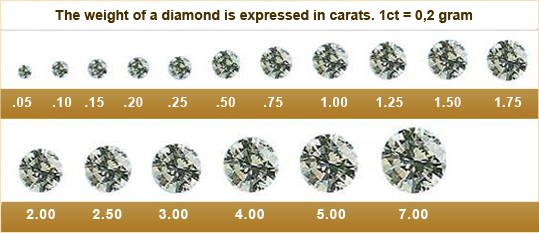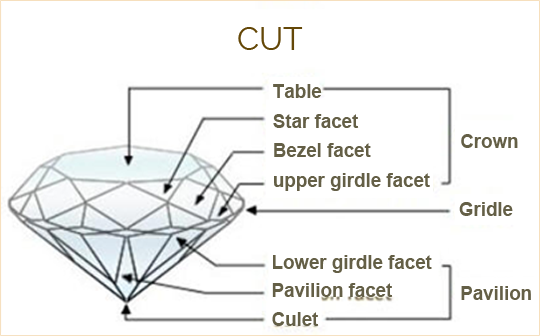A diamond’s weight is measured in carats or carat points
(1 point = 100th of a carat)
It is the internationally used unit to measure the weight of diamonds.
Carats refer to the size of the diamond. Each carat has one hundred points. The carat weight refers to the mass of a diamond.
The carat, the standard unit of weight for diamonds and other gemstones, takes its name from the carob seed. Because these small seeds had a fairly uniform weight, early gem traders used them as counterweights in their balance scales.

A diamond’s colour is graded from ‘D’ through to a ‘Z’.
Colour is graded by comparison to master stones under standardized artificial light, equivalent to Northern Daylight.
The Gemological Institute of America (GIA) rates the body color in white diamonds from D (colorless) to Z (light yellow).
The differences from one grade to the other are very subtle and it takes a trained eye and years of experience to color grade a diamond.
Here, at Bullion Exchange Jewellers, we maintain strict quality control to ensure our diamonds range from Colourless (F) to Near Colourless (G) on the GIA Colour Grading System.

A diamond’s clarity is graded from IF/ LC through to a I3/P3.
While nearly all diamonds have impurities/imperfections/inclusions, the diamond industry has set standards which grade diamonds from ‘Flawless’ (IF/LC) – rated as such if under 10x magnification no internal or external imperfections are found – to ‘I3/P3’ – rated as such if imperfections are so obvious that they are visible to the naked eye with great ease. Bullion Exchange Jewellers only use diamonds with a Grading of VS1 or better.
We reject any treated or chipped diamonds.

An understanding of diamond cut begins with the shape of a diamond. The standard Round Brilliant is the shape used in most diamond jewelry and is the most popular stone used in Solitaire Rings.
Princess cut diamonds are gaining popularity and is second to only the Round Brilliant diamond.
All others are known as fancy shapes. Traditional fancy shapes include the marquise, pear, oval and emerald cuts. Cut can be used to describe the proportions (angles of inclination and proportional relations between the various parts of the stone) and finish, which is mainly concerned with symmetry deviations and the positioning of the facets.
The traditional 58 facets in a round brilliant diamond, each precisely cut and defined, coupled with the symmetry and polish of the stone, is what gives our diamonds Brilliance, Fire and Scintillation.

